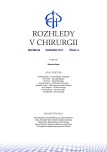Pulmonary contusion
Authors:
A. Stolz; J. Schützner; R. Lischke
Authors‘ workplace:
3. chirurgická klinika 1. LF Univerzity Karlovy a FN Motol, Praha
přednosta: prof. MUDr. R. Lischke, Ph. D.
Published in:
Rozhl. Chir., 2017, roč. 96, č. 12, s. 488-492.
Category:
Review
Overview
Pulmonary contusion is a common finding after blunt chest trauma. It occurs in 23–35% of all cases. Alveolar capillaries are injured due to the trauma, which results in accumulation of blood and other fluids within lung tissue. The fluids interfere with gas exchange, leading to hypoxemia. The consequences of pulmonary contusion include ventilation/perfusion mismatching, increased AV shunts and loss of compliance of lung parenchyma. These physiological consequences are manifested within hours from injury and usually resolve in 7 days. Computed tomography (CT) is a sensitive and main diagnostic tool. Clinical symptoms include hypoxemia and hypercapnia, manifested predominantly during 72 hours from injury. Patients are treated primarily conservatively; surgery may be needed due to haemothorax associated with lung contusion or progression of AV shunts due to localized pulmonary contusion.
Key words:
pulmonary contusion − blunt chest trauma − computed tomography
Sources
1. Cohn SM, DuBose JJ. Pulmonary contusion: an update on recent advances in clinical management. World J Surg 2010;34:1959−70.
2. Ganie FA, Lone H, Lone GN, et al. Lung contusion: a clinico-pathological entity with unpredictable clinical course. Bull Emerg Trauma 2013;1:7−16.
3. Bonacchi M, Spina R, Torracchi L, et al. Extracorporeal life support in patients with severe trauma: an advanced treatment strategy for refractory clinical settings. J Thorac Cardiovasc Surg 2013;145:1617−26.
4. Fiala P, Lischke R. Tupé poranění hrudníku. Rozhl Chir 2005;84:334−41.
5. Cho HJ, Jeon YB, Ma DS, et al. Traumatic pulmonary pseudocysts after blunt chest trauma: prevalence, mechanism of injury, and computed tomography findings. J Trauma Acute Care Surg 2016;79:425−31.
6. Miller PR, Croce MA, Bee TK, et al. ARDS after pulmonary contusion: accurate measurement of contusion volume identifies high-risk patients. J Trauma 2001;51:223−30.
7. Rodriguez RM, Friedman B, Langdorf MI, et al. Pulmonary contusion in the pan-scan era. Injury 2016;47:1031−4.
8. Mommsen P, Zeckey C, Andruszkow H, et al. Comparison of different thoracic trauma scoring systems in regards to prediction of post-traumatic complications and outcome in blunt chest trauma. J Surg Res 2012;176:239−47.
9. Bulger EM, Edwards T, Klotz P, et al. Epidural analgesia improves outcome after multiple rib fractures. Surgery 2004;136:426−30.
10. Antonelli M, Conti G, Moro ML, et al. Predictors of failure of noninvasive positive pressure ventilation in patients with acute hypoxemic respiratory failure: a multicenter study. Intensive Care Med 2001;27:1718−28.
11. Bosarge PL, Raff LA, McGwinn G, et al. Early initiation of extracorporeal membrane oxygenation improves survival in adult trauma patients with severe adult respiratory distress syndrome. J Trauma Acute Care Surg 2016;81:236−43.
Labels
Surgery Orthopaedics Trauma surgeryArticle was published in
Perspectives in Surgery

2017 Issue 12
Most read in this issue
- Pulmonary contusion
- Ruptures of the diaphragm
- Myxoid liposarcoma localised in the peritoneal cavity − case report
- Chest injuries in polytraumatized children
